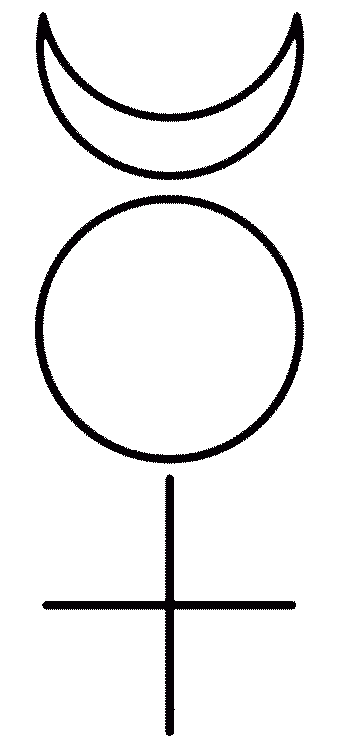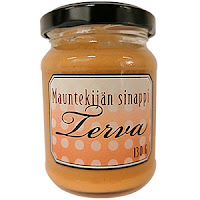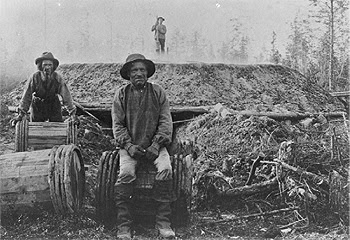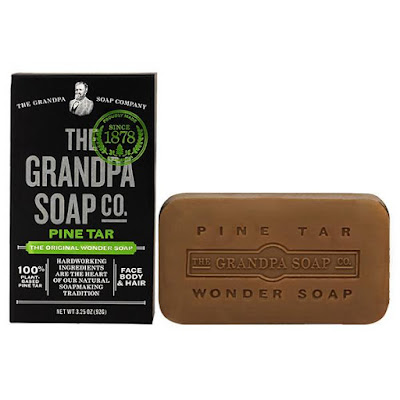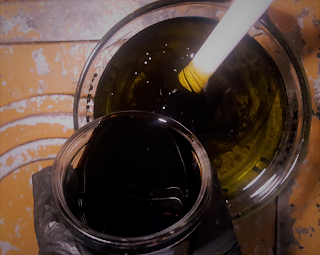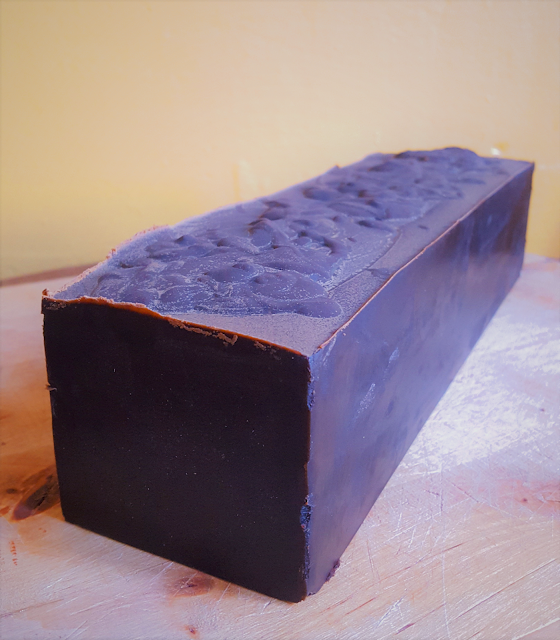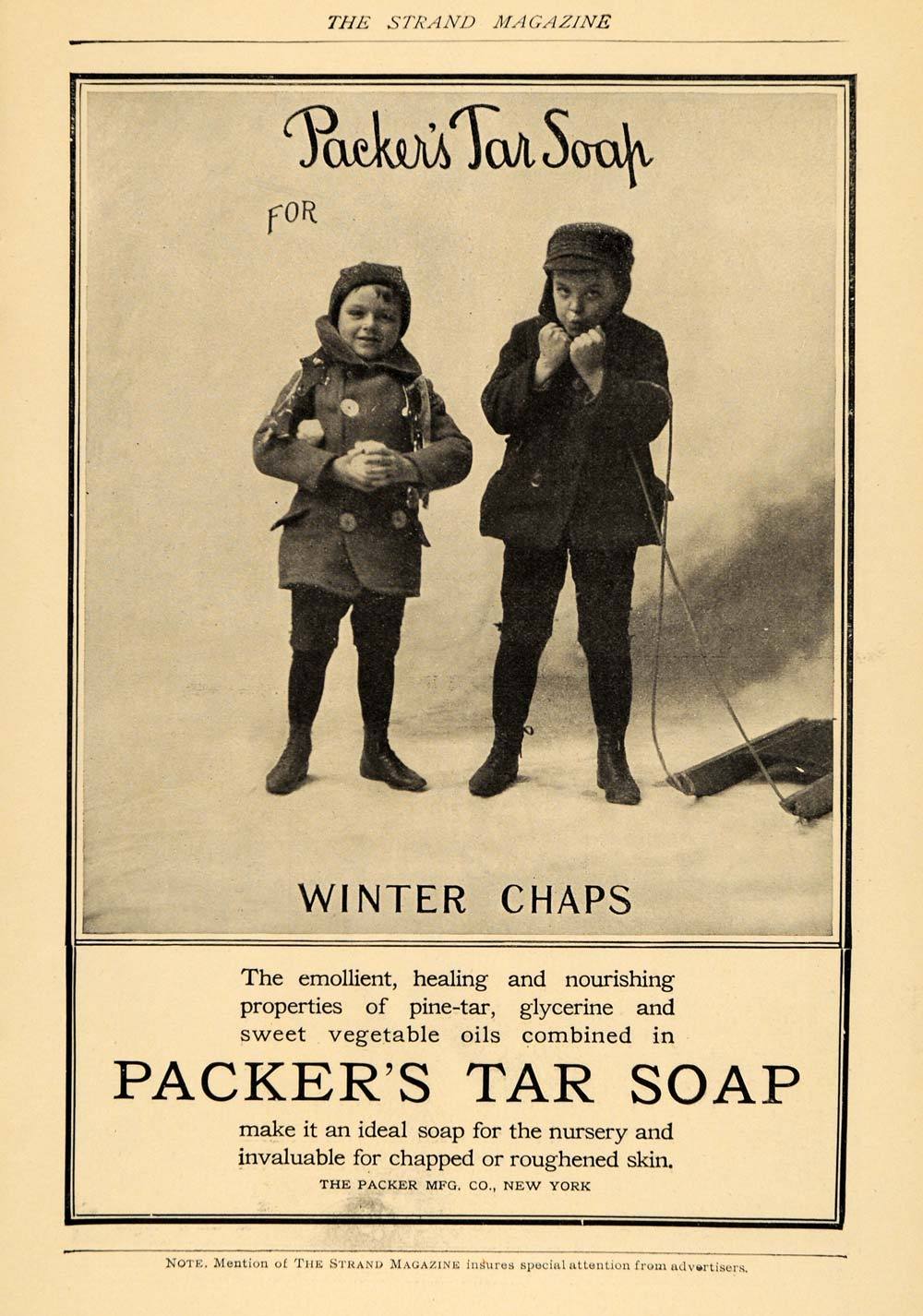Soap for Hunters
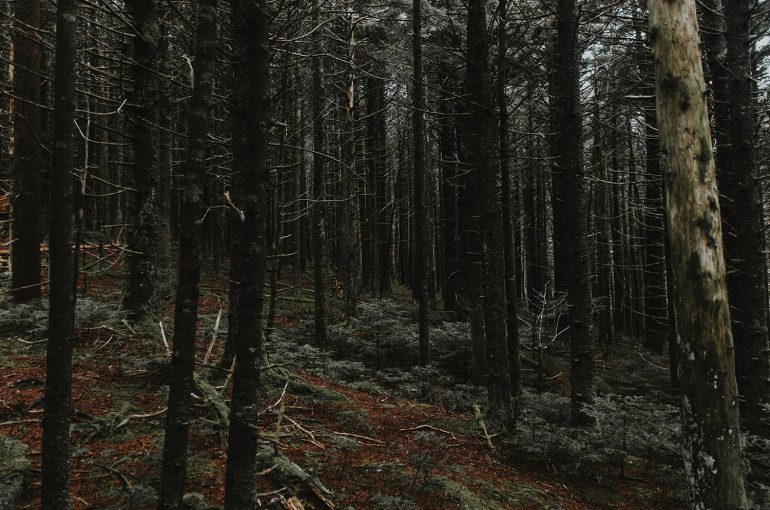
“Terva” is the Finnish word for tar and is related to the word “terve”, which translates to “healthy” or “hello”. In Finland tar is used for buildings, food products such as ice-cream, liquor, candy and even mustard with pine tar taste. Pine tar was just recently registered in the EU-chemicals list and it is interesting, that they don’t mention the creosote free tar used for cosmetics or foods production. I have eaten on daily bases Finnish pine tar candy called “Terva Lejona”, which translates to “Tar Lion”. Sounds like healthy lion to me.
First I came across pine tar while living in northern Finland, near the city of Oulu, which once was the main port for tar to reach foreign lands. Almost every Finnish sauna I seen, had soap or shampoo consisting pine tar. The smoky, leathery aroma was everywhere during the summer. It embodies memories from fire and wood, which fuel my soul. It is the kind of nostalgic scent, which fires engines, sails boats, rides horses, skiing on ice rooftops with long white beards.

Fairies running naked through pine tree forests, falling asleep over silver moss. Clearly I miss Finland and the many natural clean aromas from the forest. In a world made of petroleum oil, wood seems like an element of deficiency in my city life. Another eco-friendly product I am not finding in Germany is the “Mäntysuopaa” liquid soap, which was perfect washing detergent for my carpets. I use to dry them on the sunny sea shore for couple of days and afterwords my whole room would have this pure, clean feel. Pine soap is the most commonly used alkaline washing liquid in Finland. The soup was made from pine oil extraction, which is a by-product of the pulp cooking. There is so much forest in Finland per capita, which gives the forest industry still major role. After the decline of paper production in recent years, new technologies have been developed for skin cream, snacks and plastic replacements from wood.

The cream looks and feels like a normal, creamy soft cosmetic should. You wouldn’t think that it’s made from wood. The emulsifier used in the cream, or the component that binds water and oil, is hemicellulose, a by-product of the forest industry. Hemicellulose is a polysaccharide found in plant cell walls; it is a carbohydrate that in trees is responsible for their flexibility. Thanks to hemicellulose, a tree will not snap in strong wind, but will sway and bend with it. Cellulose is the component that makes the wood harder. Yes, Finland has long history with the wood use, and so many interesting products are delivered from a simple wood. So let me now introduce you to the story of the pine tar.
Pine tar is often made from the waste roots and stumps of pine trees cut down for lumber. The wood is slowly heated in the absence of oxygen in a process called pyrolysis. The heat turns some chemicals in the wood into a dark, sticky liquid tar that oozes out of the wood. The solids that remain are converted into charcoal. The absence of oxygen during this process prevents the charcoal and tar from burning.
The smoky-smelling pine tar was made in huge quantities in the era of wooden sailing ships. It was used in the packing material (oakum) that sealed the cracks between planks in ships’ hulls. It has been also used in veterinary for medical purposes. Nowadays, the market for pine tar is small but steady. It is used on baseball bats to improve grip and on horses’ hooves as a protective dressing. It is sometimes used as a protective coating on wood buildings, fences, and other outdoor structures. In Finland pine tar is commonly used for boat and sauna wood preservation. The charcoal is used for cooking, in blacksmiths work, or any other purpose that needs a hot, nearly smokeless fire. Tar was made also from birch trees.
About the most bizarre uses of the pine tar through the World’s history, was a punishment. It was recorded from the 17th century in USA, about public torture called tarring and feathering, which involved naked man covered in hot sticky tar and then rolled in to feathers or something like that.

The Finnish Pine Tar Tale
The tar was already used during the pile construction period around 4000 – 1800 BC. Pliny, a Roman historian who died in 79, wrote that tar water was already used in ancient Egypt to protect roofs and ships, and to embalm the bodies.
In Europe, tar was produced in the Middle Ages, particularly in the Prussian region. The decline of forests in Europe led to a shift in the direction of northern Europe. In Finland, tar burning came from Europe and Russia. Its exact time of arrival is difficult to estimate, but tar has been produced in our country for centuries. Already in the 16th century it was exported in small quantities abroad.
Tar was Finland’s first export product in the 15th century. Firstly the sea side forests were mainly used for the tar product export. Later in the 18th century the industry moved towards the east Finnish lands, where the forests were still untouched and big part of the pine tar industry was located in the area of Oulu and Kainuu. The process of making pine tar was long and time consuming. The wood was gathered for about four years. Afterwords in spring time, wood pile was created and burned during the June-July months. The fire was burning for about a week long and the heat was between 170-420°C. From one burning usually 40-45 barrels of tar were produced. One barrel was about 125 liters.
For the transportation of the tar barrels from the east forests, to the west sea side city of Oulu, were used specially made boats. Those boats would carry about 20 barrels of tar and will take up to 2-3 weeks to reach the sea port.
For a long time, tar burning in Finland had been mainly household burning. Previously, tar was in the houses by the barrel. There were many uses for it. It was used for almost everything that was required to withstand weather variations and humidity. Tar was used, among other things, as a medicine. in the treatment of rashes and as a wood preservative. Tarred wood ceilings are known as shingle roofs. Wooden boats and oars were also salvaged. Both forms of tar use have survived to the present day. Skis and clothes also got their share of tar. Wooden parts of tools, sledges and carts also got a layer of tar on their surface. Let’s use pitch oil produced from it as an insect repellent.
The important role of tar in people’s lives is evident in the form of the following old Proverbs:
“If sauna, liquor or pine tar don’t help,
the disease is death”.
Pine Tar as a Skin Remedy
Pine tar soap is old-fashioned way to heal psoriasis, eczema and other skin rashes. In the use for soap making or any other product for skin use, pine tar needs to be without creosote, which acts as carcinogen. Creosote is by-product of burning minerals during the making process. Finding creosote pine tar is not the easiest thing. I had to order mine from Etsy soap re-seller. To sell the soap for skin condition treatments, one has to label it as a drug and not simply cosmetic. So, this kind of pine tar soaps are simply called “natural soaps”.
It is still questionable weather pine tar is beneficial for the skin. There has not been done many studies on the subject, but at least in countries like Finland it has been used for decades in cosmetics. In countries like USA, pine tar is treated as not effective drug, so it is prohibited to claim that pine tar cosmetic products have any health benefits. Although “Beard Soap” or “Grandpa Soap” has long history in the country of removing dandruff and treating eczema, even that there are only 5% of pine tar in such products.
In Russia the tar shampoo industry is huge. Mainly sold for dry seborrhea with recommended use not more than three times a week and only for problematic skin and scalp irritations. You will notice that the hair grows faster, because the tar in the soap increases blood flow to the hair follicles. The tar is told to have antiseptic properties and removes fungus that is thought to cause itching and flaking. Tar acts as re-generator and softens the course of the disease.
According to the finish pine tar shampoo or soap consumers, pine tar helps to remove skin irritation and soothes the skin. Summarizing information from specialized forums, it can be concluded that the composition of cosmetics contains tar, which helps to fight oily dandruff. Doctors involved in treating the disease say that the beneficial properties of tar can be used not only for treatment but also for disease prevention. Tar soap is also suitable for intimate hygiene. Researchers found that women using tar soap are less susceptible to gynecological diseases. Soap helps with moss. It’s a good idea to use it after or even during the bikini area. It heals micro wounds and skin is less injured.

Tar soap, for all its merits, has contraindications. It is better not to use it if you are prone to allergies or have kidney problems. In addition, it is not recommended for people with thin, dry skin. Also to be avoided by pregnant women. If you wash regularly with tar soap, rinse it with cool water, then be sure to apply a nourishing cream. Birch tar is produced by distilling birch bark. In the past, tar had a special, respected place. It was used to heal eczema, ulcers, psoriasis, lichen, and was even taken orally. Tar soap was very popular for its simplicity and ease of use.
Because of the strong odor, the tar soap is often ignored. If you use it at night, there will be no smell in the morning. Using tar soap can help you get rid of many cosmetic imperfections.
Common baby, light the Campfire
The pine tar soap making process is told by many to be difficult, because the tar is quickly thickening. This was not an issue for me. My first batch was velvet and soft, easy to pour. The process is basically the same as any other soap, except for mixing the sticky tar with the oils in between. My second pine tar soap batch turned out more solid. I used both times this tar soap recipe, which is simple and has no palm oil or lard, which I prefer not to use in my products. Apparently by mixing longer the batter gets thicker. And perhaps depending on the oil substance, the batter thickness may vary.

The main question when making pine tar soap is of course how much tar to add to the soap. It seems that most soap makers use between 10% to 15% tar. Some makers claim in order to have effect, one needs to use 20%. The soap I made with 10% tar has rich aroma, long lasting softness and I have received positive feedback from everyone who has tested it. If you like to purchase my soap, I have it on sale on my Etsy shop.
Whatever pine tar you find in the store, make sure that it is labeled as 100% pure pine tar. And I would not use other than creosote free substance for any cosmetics. Although we consume much of carcinogenic barbecue or deep fried foods, that does not mean they are healthy. I believe it is hard to imagine that any pine tar substance would be absolutely free of carcinogenic compounds, I would at least try to find the purest pine tar for any soaps used on my skin.
Pine Tar Soap Recipe
Liquid & Lye Portion:
10 oz (283 g) cold distilled water
3.8 oz (108 g) lye (sodium hydroxide)
1 teaspoon salt (optional)
Oil & Pine Tar Portion (30 ounces total):
18 oz (510 g) olive oil (60%)
7.5 oz (213 g) coconut oil (25%)
1.5 oz (43 g) castor oil (5%)
3 oz (85 g) pine tar (10%)
Optional Essential Oils for Added Scent:
0.75 oz (21 g) cedarwood Atlas essential oil
0.5 oz (15 g) lavender essential oil
Directions to Make
Step 1.
Stir the 1 teaspoon of salt into the cold water. This is to help the soap release from the mold easier and is especially helpful if you’re using silicone molds. Once the salt is stirred in, pour in the lye. Make sure you’re wearing proper safety gear of goggles, long sleeves & gloves. This mixture gets hot fast and for a few moments will give off strong fumes that you should avoid breathing in.
Step 2.
Set the lye solution aside to cool. I left mine sitting for several hours until it reached room temperature. (In my house, that’s around 75 to 80 degrees F.) Normally, I work with higher temperatures, but pine tar soap needs cooler ones than normal, to help prevent it from setting up too fast.
Step 3.
While the lye is cooling: Prepare your mold and measure the oils in a stainless steel, heat proof plastic, or enamel container. Melt the coconut oil just until it turns liquid and mix with the other oils. Set the oils aside until ready to mix. (They can be around room temperature too.)
Step 4.
When you’re ready to make your soap, add the pine tar to the oils and stir until blended.
Step 5.
Pour in the lye solution and stir with a heavy duty plastic or silicone spoon or spatula. You’ll notice the soap batter get thicker fairly quickly. It may take around 4 to 5 minutes to thicken, stirring by hand, depending on temperatures used.
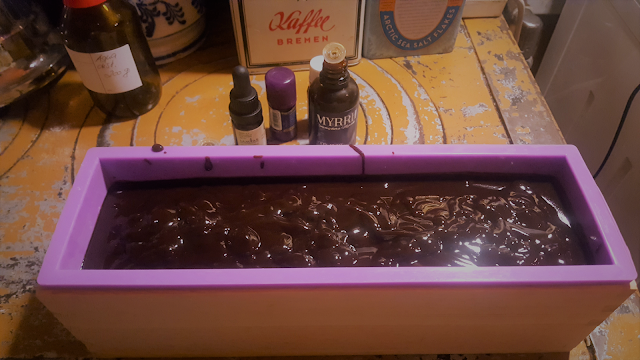 |
| Ready to sleep in silicone mold pine tar batter |
Step 6.
Pour the thickened soap batter into the mold and set aside. You don’t need to cover or insulate this soap.
Step 7.
In 48 hours, you can try unmolding. Pine tar soap starts off a little soft but firms up as it cures in the air. If you added salt to the lye water, it should unmold a lot easier for you than if you didn’t.
Step 8.
Slice into bars and let cure for at least four to six weeks.
More Tar Cosmetic Recipes
Cleansing tar face mask
This product is only suitable for greasy or mixed skin complexion. It actively removes harmful substances and impurities through the pores, removes also excess fat and treats acne.
Grate 0.5 tbsp of 1 tar soap and mix it with a nourishing cream. Apply a thick layer to the entire face, bypassing the eye area. After 15 minutes wash with plenty of cool water.
Tar and honey face mask
It has most effective anti-inflammatory processes, alleviates irritation and redness, and cures a variety of rashes. 1 tsp Tar is mixed with 2 tsp of melted honey. Apply tin layer on the skin. After 15 minutes rinse with cool running water.
Olive oil tar mask
Because the product contains olive oil, this mask is double perfect for dry skin irritations and rashes.
Heat 3 tbsp of Honey in a water bath, then mix it with 1 tsp Olive Oil and 1 tsp Birch Tar. Apply a dense coat to all areas of the face. After 15 minutes, wash the mask with warm water and use a nourishing cream after.
The pine tar aroma filled my tiny city kitchen and I enjoyed the woody campfire feel in the air.
Tar Cosmetic Recipes:
https://paahtaja.vuodatus.net/lue/2009/11/tervasaippua
https://www.thespruce.com/pine-tar-soap-recipe-516687
http://www.kimberlymcnutt.com/Making-Pine-Tar-Soap.html
https://fi.cosmedicnorge.com/degot-na-lico.htm
How to make your own birch tar (in Finnish):
https://fi.rybinsk.info/2357-21-unusual-way-to-use-birch-tar-in-the-garden.html
Tar Products:
http://OncaRitualOfferings.etsy.com
https://beauty-fi.htgetrid.com/shampun/degtyarnyj/
https://www.saunahiisi.com/tuote/ikikelpo-saunavoide-mantyterva-ja-hunaja-125-ml/
https://www.etsy.com/listing/741754997/night-vision-pine-tar-skull-soap?ref=shop_home_active_3
https://www.sokos.fi/fi/sokos/frantsila-19g-lemminkaisen-aidin-terva-pihka-salva
https://www.yourvismawebsite.com/hellapoliisi-verkkokauppa/shop/product/rento-loylytuoksu-400-ml-terva?tm=etusivu&sm=
https://www.osmia.fi/tuotteet/shampoot
https://www.tokmanni.fi/vm-puuterva-6419726972005
Resources:
http://blog.drsquatch.com/pine-tar-soap-benefits/
https://greatist.com/health/tar-soap-for-psoriasis#types-of-tar-products
http://www.kainuunterva.com/index.php?option=com_content&task=view&id=14&Itemid=40
https://thenerdyfarmwife.com/pine-tar-soap-recipe/
https://classicbells.com/soap/pineTarSoap.html
https://luontomaisemaymparisto.wordpress.com/tag/terva/
https://www.thesprucecrafts.com/pine-tar-soap-recipe-516687
https://www.flickr.com/photos/appalachianheritagesoaps/5948213390/in/photostream/lightbox/
